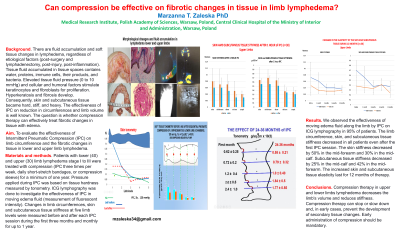Clinical Research
(CR-066) Can compression be effective on fibrotic changes in tissue in limb lymphedema?
Friday, April 28, 2023
7:15 PM - 8:30 PM East Coast USA Time

Introduction: There are fluid accumulation and soft tissue changes in lymphedema, regardless of etiological factors (post-surgery and lymphadenectomy, post-injury, post-inflammation). Tissue fluid accumulated in tissue spaces contains water, proteins, immune cells, their products, and bacteria. Elevated tissue fluid pressure (0 to 10 mmHg) and cellular and humoral factors stimulate keratinocytes and fibroblasts for proliferation. Hyperkeratosis and fibrosis develop. Consequently, skin and subcutaneous tissue became hard, stiff, and heavy. The effectiveness of IPC on reduction in circumferences and limb volume is well known. The question is whether compression therapy can effectively treat fibrotic changes in tissue with edema. Aim. To evaluate the effectiveness of Intermittent Pneumatic Compression (IPC) on limb circumference and the fibrotic changes in tissue in lower and upper limb lymphedema.
Methods: Patients with lower (40) and upper (30) limb lymphedema stage I to III were treated with compression (IPC three times per week, daily short-stretch bandages, or compression sleeve) for a minimum of one year. Pressure applied during IPC was based on tissue hardness measured by tonometry. ICG lymphography was done to investigate the effectiveness of IPC in moving edema fluid (measurement of fluorescent intensity). Changes in limb circumferences, skin and subcutaneous tissue stiffness at five limb levels were measured before and after each IPC session during the first three months and monthly for up to 1 year.
Results: We observed the effectiveness of moving edema fluid along the limb by IPC on ICG lymphography in 95% of patients. The limb circumference, skin, and subcutaneous tissue stiffness decreased in all patients even after the first IPC session. The skin stiffness decreased by 50% in the mid-forearm and 30% in the mid-calf. Subcutaneous tissue stiffness decreased by 25% in the mid-calf and 42% in the mid-forearm. The increased skin and subcutaneous tissue elasticity last for 12 months of therapy.
Discussion: Compression therapy in limb lymphedema decreases the limb's volume and reduces its stiffness. Compression therapy can stop or slow down and, in early cases, prevent the development of secondary tissue changes. Early administration of compression should be mandatory.
Methods: Patients with lower (40) and upper (30) limb lymphedema stage I to III were treated with compression (IPC three times per week, daily short-stretch bandages, or compression sleeve) for a minimum of one year. Pressure applied during IPC was based on tissue hardness measured by tonometry. ICG lymphography was done to investigate the effectiveness of IPC in moving edema fluid (measurement of fluorescent intensity). Changes in limb circumferences, skin and subcutaneous tissue stiffness at five limb levels were measured before and after each IPC session during the first three months and monthly for up to 1 year.
Results: We observed the effectiveness of moving edema fluid along the limb by IPC on ICG lymphography in 95% of patients. The limb circumference, skin, and subcutaneous tissue stiffness decreased in all patients even after the first IPC session. The skin stiffness decreased by 50% in the mid-forearm and 30% in the mid-calf. Subcutaneous tissue stiffness decreased by 25% in the mid-calf and 42% in the mid-forearm. The increased skin and subcutaneous tissue elasticity last for 12 months of therapy.
Discussion: Compression therapy in limb lymphedema decreases the limb's volume and reduces its stiffness. Compression therapy can stop or slow down and, in early cases, prevent the development of secondary tissue changes. Early administration of compression should be mandatory.

.png)